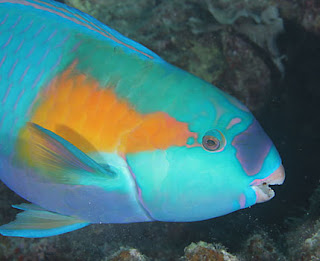Sea horses and their close relatives, the pipefishes and sea dragons, have a distinctive appearance. Unlike other bony fish, the elongated bodies of these animals are supported by rings of bone. All of these fish feed through tubelike mouths that suck in small crustaceans and other prey. Instead of chasing their food, they quietly hover in the water and wait for something edible to swim by.
A sea horse, swims upright among the corals or sea grasses, moving slowly from one perch to another. To keep from drifting away, a seahorse may hold in place by wrapping its prehensile tail around a plant or piece of coral. Pipefish and sea dragons swim like other kinds of fish, with their heads leading. A pipefish has a long, thin shape, so it resemble grass or reeds. In contrast, sea dragons are covered in leaflike appendages that help camouflage them as they float in beds of leafy seaweeds.
 |
| A sea horse clings to marine plants with its prehensile tail. |
In all groups, the males take care of the eggs. After eggs form in the female’s body, they are transferred to a thinskinned pouch on the male. He fertilizes the eggs, then carries them until they develop and hatch, providing them protection from predators.
The surgeonfish, a group that includes the tangs, are represented by more than 70 species on the reef. All are brightly colored and have oval bodies that are wide and flat. Surgeonfish get their name from the scalpel-like scales that grow at the base of their tails. These razor sharp scales remain folded neatly against the body most of the time but become erect when they sense danger. Surgeonfish can seriously wound predators by swimming beside them, lashing their bodies back and forth.
 |
| Surgeonfish |
Most surgeonfish species are herbivores. They swim around the reef in small groups grazing algae, very much like a herd of cows might roam through a pasture. Their small incisorlike teeth are adept at scraping algae off the rocks and reef. Occasionally, a large group of surgeonfish will overwhelm a territorial damselfish and gorge on the “farmer’s” algal garden.
A close relative of the surgeonfish is the graceful Moorish idol (Zanclus cornutus), which can grow to 8 inches (20 cm) and is distinguished by a long dorsal fin. Using its protruding lips and long snout, the Moorish idol probes into crevices for food that many other fish are unable to reach. Sponges are the fish’s favorite food, but it also feeds on algae.
Butterfly fish (family Chaetodontidae) are some of the most colorful reef fish. These beautiful animals flitter around the reef with a butterfly-like motion. They primarily feed on coral polyps, although they may also consume small invertebrates. When feeding, butterfly fish tend to bite off several polyps within a small area, then move on to another place, a technique that does not kill the coral. Most live in male-female pairs, and together they claim and protect regions of coral from intruders.
The flattened bodies of butterfly fish offer them some protection from predators. They can easily slip into cracks in the reef where they open their fins to wedge their bodies tightly in place. The fish are so thin that they seem to disappear when they face a predator head on. Butterfly fish, such as the spotfin butterfly fish in the lower color insert on page C-7, further confuse their enemies with a large eyespot near their tails. These marking can fool a predator into lunging for the wrong end of the animal. There are many different species of angelfish. Food choices vary by species, but as a group angelfish are daytime feeders that favor sponges, tunicates, and algae, nibbling at them with their brushlike teeth. Most species are very territorial, often occupying and defending a small cave or some other space for several years.
As in parrot fish, all individuals in certain species of angelfish begin life as females. As they mature, a number of the females change into males. Color plays an important role in angelfish interactions. The two sexes can be visually distinguished by their slightly different coloring, and the marking and colors of juveniles are different from those of adults. This may protect the young fish from aggressive adults of their own species.
 |
| Parrot fish |
Remoras are slim fish that are usually 1 to 3 feet (0.9 m) long. Their dorsal fins are modified into sucking disks, which they use to attach themselves to sharks, whales, rays, or turtles. This behavior may benefit the remora, who often eats the leftovers from its host’s meals. Being attached to a big animal also protects the smaller fish from predators. If it chooses to do so, the smaller fish can swim away from its host to forage. If no hosts are available, remoras will form schools that swim around in spiral patterns, with the largest animals on bottom and the smallest on top.
 |
| Remoras |
